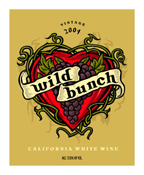 |
|
Wine Details
Price:
$10.00 per bottle
Description:
Everyone has a wild side. Wild Bunch White is a blend of Chardonnay, Chenin Blanc, Pinot Grigio, Muscat, and Sauvignon Blanc. Drink with scrambled eggs, when salsa dancing, or wherever your groove is on. Whiffs of lemon zest, honeysuckle, and orange. Juicy wet flavors of apple and pear roll over the palate into a long finish.
|
|
|